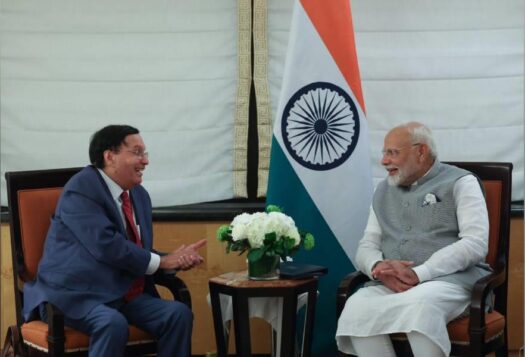
A few days ago, an Indian news agency, Press Trust of India (PTI), reported that Indian security agencies had intercepted a ship that was bound for Karachi from China at Mumbai’s Nhava Sheva Port. The ship was stopped because it was suspected to be carrying a “dual-use consignment” that could find its way into Pakistan’s nuclear and ballistic missile program. The interception, done by Indian customs officials on the basis of an intelligence input, stopped the Malta-flagged merchant ship CMA CGM-Attila on January 23.
India’s Defense Research and Development Organization (DRDO) went through the shipment and revealed that it included a computer numerical control (CNC) machine, produced by an Italian company. The DRDO also established its potential use in Pakistan’s nuclear program. Various Indian media reports said that the shipment with CNC machines had originated from China and was headed for “Pakistan Wings Pvt. Ltd.” in Sialkot. Further investigation, according to media reports, revealed that part of the consignment was for “Cosmos Engineering,” a Pakistani defense supplier that has been under internal investigation for about two years now.
India is not a stranger to China-Pakistan collaboration in proliferation of nuclear and missile technologies, but such interceptions have not happened in a while.
CNC machines have been controlled under the Wassenaar Arrangement (WA) since 1996. The WA is one of the global export control regimes designed to stop proliferation of dual-use items, that is, items that have both civilian and military uses. The relevance of CNC machines in nuclear and missile programs has been known for a while. Reportedly, North Korea has been using smuggled CNC machines in its nuclear program.
India has been a member of the WA since December 2017. As India’s Ministry of Externals Affairs put it, the WA, “through information exchange among members on transfers of conventional arms and dual-use goods and technologies, seeks to promote transparency and greater responsibility in such transfers and prevent destabilizing accumulations.” India “remains ready and committed to work in close cooperation with other members to further the WA goal,” the MEA added.
India is not a stranger to China-Pakistan collaboration in proliferation of nuclear and missile technologies, but such interceptions have not happened in a while. Even a cursory look at the history of nuclear and missile proliferation in India’s neighborhood provides plenty of evidence of China-Pakistan proliferation networks. China gave Pakistan a nuclear weapon design, which subsequently made its way to Libya. India has remained particularly concerned about it because transfers from China and North Korea have been used to build up Pakistan’s missile program.

Further, Pakistan’s diversion of some nuclear and missile technology to others, including North Korea and Iran, has been worrisome. The A.Q. Khan episode demonstrated an extensive proliferation ring that Pakistan managed to establish across Asia and the Middle East. Though Pakistani officials claimed that Khan operated alone, this claim has met with considerable skepticism.
The recent transfers are somewhat unusual. When China joined the Nuclear Non-Proliferation Treaty (NPT) in the early 1990s, and later the Nuclear Suppliers Group (NSG), it made commitments that it would work to strengthen global non-proliferation goals. But the links with Pakistan suggest that Beijing hasn’t entirely lived up to its promises.
Although China has not been as active in supporting such transfers as it has been in the past – quite possibly because Pakistan has already acquired most of the technologies it needs – India has been watchful. New Delhi is particularly concerned about China’s assistance to Pakistan in gaining access to restricted items from Europe and the United States.
New Delhi worries about the continuing deep links between China and Pakistan, its two main military and political adversaries.
In one incident in February 2020, India caught suspected dual-use items being shipped by China to Pakistan. According to the DRDO, the 2020 incident involved the transshipment of an industrial autoclave from Jiangyin Port, China to Karachi. The shipment was stopped at Kandla Port in India on February 3, 2020. That time, too, the detaining of the ship took place on the basis on an intelligence tip-off. The autoclave on the ship was identified as an industrial dryer but the item is a dual-use technology with relevance in the production of rocket motors for ballistic missiles. Therefore, the China-Pakistan proliferation concerns continue for the Indian security establishment.
India’s concerns about nuclear and missile proliferation are well-known. India has accordingly taken a number of steps at the national and international levels to curb these destabilizing trends. At the national level, following the signing of the India-U.S. nuclear deal in 2005, India also put in place the Weapons of Mass Destruction and their Delivery Systems (Prohibition of Unlawful Activities) Act, 2005 which “prohibit[s] unlawful activities in relation to weapons of mass destruction and their means of delivery.” Similarly, despite India’s skepticism toward global non-proliferation regimes, having been a target of many in the past, India became a member of various technology control arrangements, including the Wassenaar Arrangement, the Missile Technology Control Regime, and Australia Group, and has sought membership of the NSG too, though this has been spiked by China.
Although Pakistan is already a nuclear weapon state – it has slightly more nuclear warheads than India has – India continues to remain concerned about the continued growth of Islamabad’s nuclear and missile programs. Even more so, New Delhi worries about the continuing deep links between China and Pakistan, its two main military and political adversaries. This latest interception will serve to reinforce these worries.
Also Read: Emerging Missile Technologies: A New Arms Race in South Asia?
Editor’s Note: A version of this piece originally appeared on The Diplomat and has been republished with permission from the editors.
***
Image 1: CMA CGM Atilla via Wikimedia Commons.
Image 2: Wassenaar Arrangement Meeting via Flickr.


